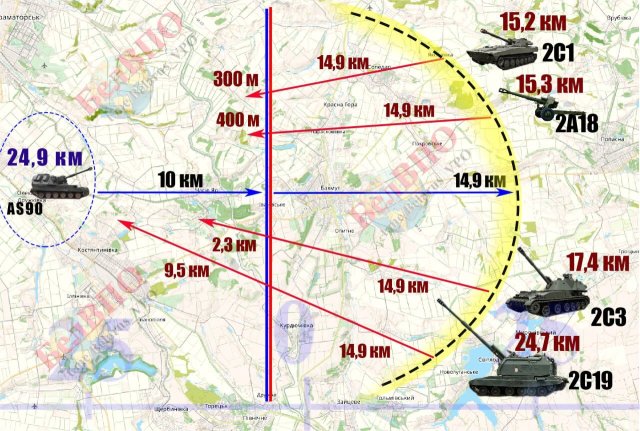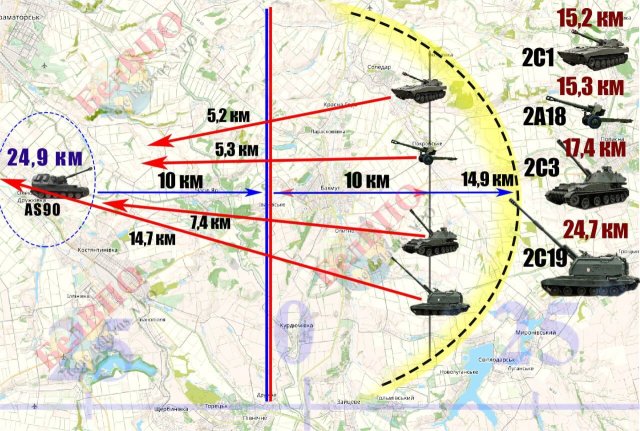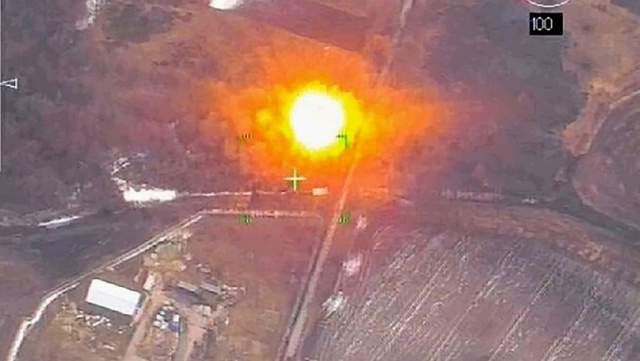Until recently, the main advantage of the AFU artillery was its range. Using NATO intelligence, it carried out strikes from long distances, remaining, in turn, virtually inaccessible to Russian artillery.
In the initial period of its counter-battery warfare, the guided projectile (US) "Krasnopol" was mainly used. In particular, with the lower edge of the cloud cover at 400 m, laser targeting for Krasnopol is impossible, which prevents them from being used everywhere. When using conventional OF shells, much more artillery equipment is required to destroy the same target. For example, to suppress one gun, an artillery platoon (3-4 guns) is needed, an artillery battery (6-8 guns) is needed for a platoon, and an artillery division (18-24 guns) is needed for a battery.
 |
| Counter-battery struggle. |
| Source: BELVPO |
Transformation of the use of artillery
Today, the APU does not fire with platoons, batteries, and even more so with divisions. The modern use of artillery is a nomadic self–propelled gun, which is able to leave the position within 1-2 minutes after the first "arrival" nearby. On our side, the process of its destruction begins from the beginning – reconnaissance, targeting, proofreading and another attempt to defeat.
Meanwhile, due to the refusal to concentrate artillery forces, the AFU had a dilemma. On the one hand, long-range NATO self-propelled guns have to be pulled closer to the foreheads. They stay here until the ammunition runs out, which deprives them of a key advantage – mobility. On the other hand, the APU sacrifice only one self-propelled gun and try to limit themselves to fire raids or even point shooting at individual targets.
 |
| Counter-battery struggle. |
| Source: BELVPO |
The Lancet becomes an indispensable tool
With the introduction of shock UAVs into artillery units, the rules of counter-battery warfare have changed. In particular, Lancet UAVs were used exclusively by special forces for reconnaissance and destruction of important targets. Today, the Lancets are the main trump card in the hands of counterbatarists. So, along with the routine destruction of the Krab and AS90 self-propelled guns, the "arrival" of the Lancet on the French CAESAR almost 60 km from the LBS, which also tried to "run away", became a kind of sensation.
Why the Lancet?
The Lancet barrage ammunition, with a range of even 40 km, allows you to reach artillery positions in the enemy's immediate rear. Meanwhile, the latest versions of the Lancet provide much broader opportunities for the destruction of the AFU artillery primarily due to the range, which exceeded 70 km.
In addition, the latest versions of the Lancets were equipped with a warhead with a so-called "shock core" or, scientifically speaking, a cumulative jet of gas heated to a plasma state. The essence of equipping this warhead is that no nets, grids and "barbecues" will protect against it. In addition to the perfect warhead, the latest version of the Lancet received thermal imagers and a laser locator, which practically does not give the AFU targets a chance of survival.
Most importantly, there is a constant development of the Lancet control system. If earlier drone operators had to "look through all eyes" to find and destroy a target, today the Lancet has been taught to work autonomously. So, they themselves detect targets, are able to work in a "swarm", while acting in any weather conditions and time of day.
What conclusions can be drawn?
Having analyzed the latest facts of the defeat of Ukrainian targets, the tactics of using artillery and conducting counter-battery warfare, it becomes obvious the emergence and development of new ways to destroy enemy firepower. Now, instead of a car of shells, one Lancet-type UAV is enough.
Nikolai Krylov

